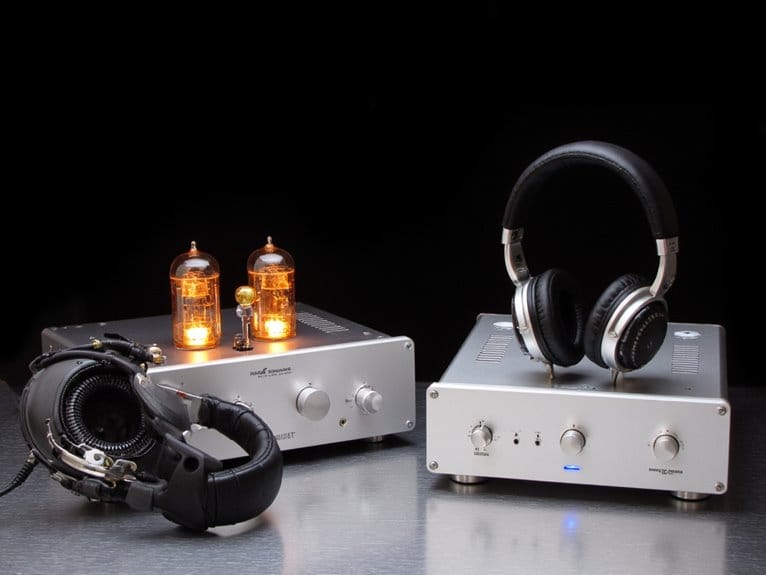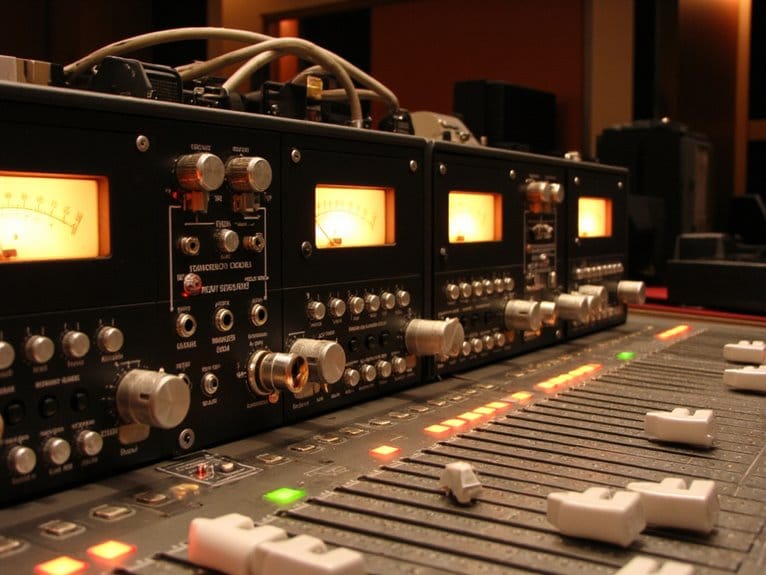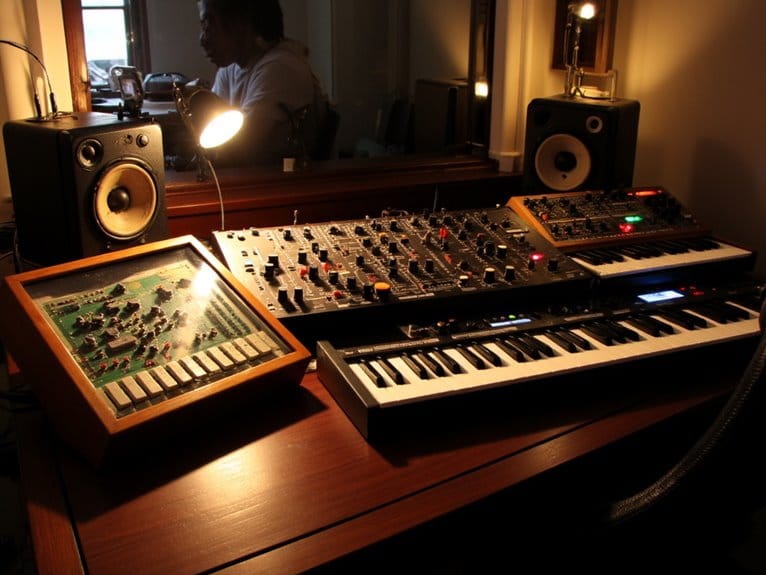Active Vs Passive Studio Monitors: Complete Comparison
You’ll find that active monitors include built-in amplifiers and offer plug-and-play convenience, while passive monitors require external amplification but provide greater customization flexibility. Active systems eliminate impedance matching issues, deliver lower distortion through enhanced bi-amp configurations, and typically cost less than equivalent passive setups when factoring in amplifier requirements. Passive monitors allow component upgrades and precise amplifier selection but demand more technical expertise during installation. Understanding these distinctions will help you make the best choice for your specific studio requirements.
We are supported by our audience. When you purchase through links on our site, we may earn an affiliate commission, at no extra cost for you. Learn more.
Notable Insights
- Active monitors have built-in amplifiers for plug-and-play setup; passive monitors require separate external amplifiers and complex routing.
- Active systems deliver more accurate, consistent sound with optimized amplification; passive monitors vary based on amplifier quality and matching.
- Setup complexity differs significantly: active monitors need only power and audio connections while passive systems require careful component matching.
- Active monitors typically cost less overall than equivalent passive setups when factoring in required amplifiers and processors.
- Professional studios predominantly use active monitors for their reliability, precision, and integrated acoustic tuning controls for room optimization.
Understanding the Core Differences Between Active and Passive Monitor Systems
When I first started mixing music in my home studio, I’ll admit I was completely baffled by the active versus passive monitor debate—and honestly, the fundamental differences between these two systems can make or break your audio production setup.
The core distinction lies in where amplification occurs: active monitor types feature built-in power amplifiers integrated directly into the speaker cabinet, while passive designs require external amplification to function.
Active monitors pack amplifiers inside the speaker cabinet, while passive monitors need separate external amps to power the drivers.
This speaker design difference affects everything from setup complexity to sound quality, with active monitors offering plug-and-play convenience through their self-contained architecture.
Passive monitors, conversely, rely on separate amplifiers, creating a modular system that demands more technical knowledge but provides greater customization flexibility for experienced users. Active monitors eliminate the need to match impedance and power ratings between separate components, providing reliable performance that reduces potential compatibility issues. Many active monitors incorporate bi-amp configurations that send different frequencies to separate amplifiers within the same unit, enhancing overall sound clarity and precision.
Evolution From 1967 to Modern Studio Standards
The studio monitor landscape has undergone dramatic transformation since the late 1960s, evolving from basic passive designs requiring external amplification into today’s sophisticated active systems with built-in DSP processing and precision-engineered acoustic components.
I’ve watched studio evolution accelerate dramatically, particularly when JBL’s D50 monitors displaced Altec’s industry-standard 604 series at major facilities like Capitol Records.
The shift toward monitoring technologies became even more pronounced during the 1980s when Genelec introduced their revolutionary DCW™ waveguide technology in 1983. This period also witnessed the emergence of near-field monitoring, which helped reduce acoustic problems for smaller studios and became the standard configuration by the mid-1980s.
Key milestones in this evolution include:
- 1983: Genelec’s Directivity Control Waveguide technology enhanced frequency response accuracy
- 2000s: DSP integration enabled real-time correction and phase alignment in compact monitors
- Modern era: Active monitors now dominate professional studios with superior reliability and precision
Sound Quality Performance and Technical Specifications
| Feature | Active Monitors | Passive Monitors |
|---|---|---|
| Frequency Response | Flat, accurate curve | Varies with amplifier |
| Distortion Levels | Lower THD ratings | Depends on amp quality |
| Power Handling | Optimized amplification | Requires external matching |
Active crossovers split frequencies before amplification, allowing precise control over each driver’s performance, while passive designs rely on post-amplification crossovers that introduce signal loss. These technical specifications directly impact your monitoring accuracy and mixing decisions.
Setup Requirements and Operational Flexibility
Based on my extensive studio experience, I’ve found that setup complexity represents one of the most significant differences between active and passive monitor systems, particularly for engineers who prioritize workflow efficiency over technical customization.
Active monitors eliminate external amplifier requirements, offering plug-and-play simplicity with just power and audio connections needed. However, you’ll sacrifice amplifier upgrade flexibility since everything’s integrated within the cabinet.
Passive systems demand careful amplifier matching and complex signal routing, but they compensate by allowing component customization and future upgrades without monitor replacement.
Key operational differences include:
- Active monitors feature built-in acoustic tuning controls for room optimization
- Passive setups require external processors for environmental calibration
- Active systems excel in multi-monitor integration through consistent internal amplification
Cost Analysis and Professional Applications
When I analyze studio monitor investments across different budget ranges, I consistently find that the cost equation between active and passive systems isn’t as straightforward as comparing unit prices alone.
While entry-level active monitors like the JBL 305P MkII start around $140 per unit, you’ll encounter significant price variations when factoring in amplification requirements for passive alternatives.
Through extensive feature analysis, I’ve observed that professional-grade active monitors, such as the Neumann KH 120 at $700-$730 per unit, deliver integrated precision that often costs less than equivalent passive setups requiring matching amplifiers.
In professional environments, active monitors dominate recording and mastering applications due to their plug-and-play convenience, accurate frequency response, and reduced long-term maintenance complexity compared to passive systems.
Frequently Asked Questions
Can I Convert Passive Monitors to Active or Vice Versa?
You can attempt passive conversion to active, but it’s technically complex and requires custom electronics work. Active benefits like integrated DSP and amplification are difficult to replicate, making purchasing dedicated monitors more practical.
Do Active Monitors Consume Power When Not Playing Audio?
Yes, you’ll find active monitors do consume power when idle, typically drawing continuous electricity even without audio playback. Power consumption varies by model, but energy efficiency improves considerably with automatic standby modes that reduce waste.
Which Type Works Better in Untreated Home Recording Spaces?
You’ll get better sound clarity in untreated rooms with active monitors since they include built-in DSP and room correction features that help manage problematic bass response and reflections that passive setups can’t address.
Are Active Monitors More Prone to Electrical Interference and Noise?
Yes, you’ll find active monitors have more interference sources since they contain built-in amplifiers and power supplies. However, you can achieve effective noise reduction using balanced cables and proper grounding techniques.
Can I Use Active and Passive Monitors Together in One Setup?
You can combine them, but monitor compatibility requires careful amplifier matching and signal calibration. Audio mixing becomes complex due to volume imbalances, tonal differences, and potential phase issues between the different speaker types.
On a final note
You’ll find that choosing between active and passive monitors ultimately depends on your studio’s specific needs, budget constraints, and technical requirements. Active monitors offer convenience, built-in amplification, and optimized component matching, while passive systems provide flexibility, upgradability, and potentially superior sound quality with high-end amplifiers. Consider your mixing environment, available space, and long-term goals when making this critical investment in your audio production setup.






